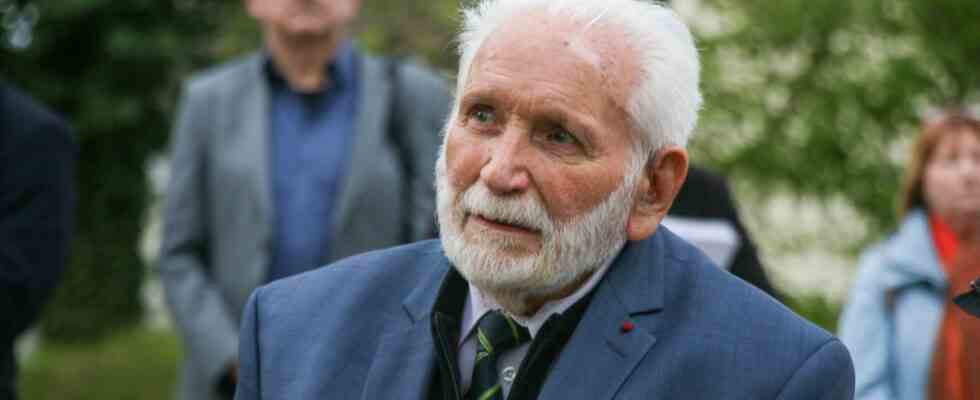The clacking of the concentration camp inmates’ clogs – that’s what he had in mind when he drove along the route of the Dachau death march on his motorcycle that day, says Oliver Westermann. With his anti-fascist motorcycle gang “Kuhle Belly” he drove the 90 kilometers from Waakirchen to Dachau this Saturday, via Starnberg, along the Würm. The route that thousands of concentration camp inmates had to walk in the opposite direction in 1945, until they were exhausted and died. The eight bikers laid roses at eight death march memorials along the way. They’ve been doing it for five years now, say the motorcyclists, who have found their own way of commemorating. Now they are standing in front of the Dachau Death March Memorial. During the final phase of the Nazi dictatorship, SS henchmen drove more than 10,000 concentration camp prisoners from Dachau through the Würm Valley and further south. Many wore only clogs, despite the snow; the clicking could be heard from afar.
The train was finally freed in Waakirchen. In order to keep the memory of the Dachau death march 77 years ago alive, the Dachau death march memorial support group invited people to an open-air event on Saturday evening on Theodor-Heuss-Strasse. “Despite the warnings of the survivors, our world remains vulnerable,” said Mayor Florian Hartmann (SPD) about these times of increasing right-wing extremism and anti-Semitism. “Liberation is never complete.” In view of the current world situation, one could “become resigned and ask oneself: do all the speeches and commemorations bring anything at all?”
Director Max Kronawitter reported how he wants to preserve the memories of contemporary witnesses with his film “Death March – When Horror Came to the Front Door”. And he told how his children asked him from the bicycle seat on an excursion what the death march sculptures along the way were all about and how difficult it was for him to explain them. This is how the film was finally made, which premiered this spring after a long wait and was also shown in the Adolf-Hölz-Haus after the commemoration in Dachau. “We need eyewitnesses to be able to recognize the people behind the shadows,” says Kronawitter. “The memory of the death march needs contemporary witnesses, even if they should fall silent.”
“My grandfather is my hero”
A touching speech was then given by Dana Bloch, the granddaughter of Abba Naor, the 94-year-old death march and concentration camp survivor and Vice President of the International Dachau Committee. “My grandpa is my hero,” says the grown-up granddaughter. “Only after the death march did he really start to live”. Abba Naor lost his 15-year-old brother Chaim in the Kaunas ghetto; his mother Chana and his six-year-old brother Berale were gassed in Auschwitz-Birkenau in 1944. Abba Naor was deported to Bavaria via the Stutthof concentration camp – to Utting and finally to the Dachau subcamp Kaufering I. When he was liberated by US soldiers on the death march near Waakirchen on May 2, 1945, he was just 17 years old.
Abba Naor refrained from a long speech, but insisted on thanking Barbara Distel, the former director of the concentration camp memorial. “She was the first to invite us to Dachau – and actually we didn’t want to come.” Most of the survivors would not have wanted to talk about the past at the time. But Naor and his friends always talked about the camp. “Because it was a part of us. It was easier to live with when you talked about it,” says Naor, adding: “Unfortunately, most of them have already died.” The three survivors who had come gathered in front of the memorial: Erich Finsches from Austria, Abba Naor from Israel and Jean Lafaurie from France.
“Liberation is never complete”: Lord Mayor Florian Hartmann in front of the death march memorial by the sculptor Hubertus von Pilgrim.
(Photo: Niels P. Jørgensen)
Abba Naor emphasizes how important it is for the survivors themselves to talk about what happened during the Nazi era.
(Photo: Niels P. Jørgensen)
Contemporary witness Erich Finsches has traveled from Austria.
(Photo: Niels P. Jørgensen)
At 98 years old, Laufaurie is probably the oldest of the group, he seems cheerful, his eyes sparkle friendly. Although he’s only wearing a cardigan under his jacket, the cool April weather doesn’t seem to bother him that evening. During what is now his third visit to Dachau, he visited the Allach satellite camp complex and had his memories recorded for the archive of the concentration camp memorial. “It’s important to keep talking about it,” says Lafaurie after the memorial event. Of the 1,200 prisoners who were then deported to Dachau with him, 400 died. “I’m here to talk about her.”
In his department, around kilometers south of Paris, he is the last survivor. Therefore he is often at schools to report on his experiences. Since the corona pandemic, people’s willingness to come to interviews with contemporary witnesses has decreased, which worries him, says Lafaurie. And of course he also noticed that there were fewer and fewer eyewitnesses.
When the Americans came, Lafaurie was in Allach. There he had previously had to lay and repair railway tracks in forced labor. When he was liberated, he still weighed 32 kilograms, Lafaurie once told a French newspaper. “It’s something you don’t forget,” he says of the liberation. Later he worked all over the world as a site manager, in Argentina, Venezuela, South Africa, Australia. As he tells it, he exudes an almost irritatingly unwavering confidence. He proudly says that today he has six children, 12 grandchildren, 28 great-grandchildren and already seven great-great-grandchildren. Lafaurie says: “Once you’ve been this close to death, you love life.”

